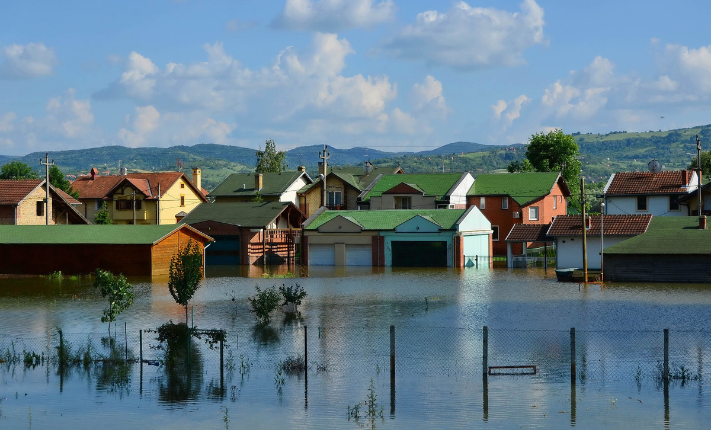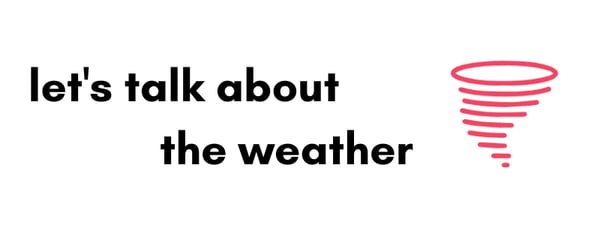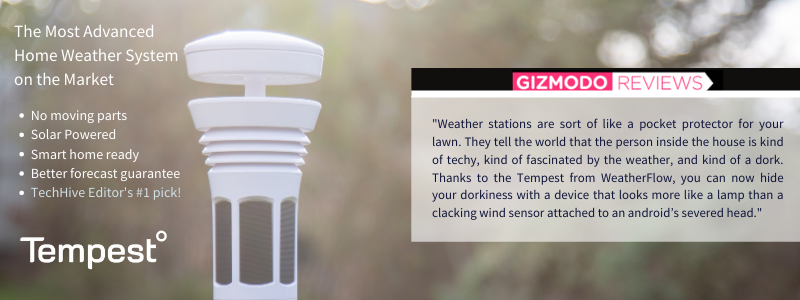Posted by Weatherflow ● October, 2020
Tempest News | October 2020

UK MET OFFICE LAUNCHES NEW TOOL
The computer program allows city planners to examine local areas and view simulations of extreme weather in the coming decades to design structures better able to withstand changing weather. Read more >>>
A GOOD YEAR FOR BAD WEATHER
“By many measures, 2020 has been disastrous. The events of this year are yet another sign of how incremental increases in temperature can lead to exponentially worse natural disasters, experts say." Read more >>>
FIGHTING A NEW KIND OF FIRE
The intensity of Colorado's recent megafires has prompted new conversations over how to mitigate and forecast fires and what wildfire management must do to keep up with the pace of environmental change. Read More >>>
Tempest innovator of the month
Tempest Innovator Peter Davis created the Tempest PiConsole - a Python console that displays real-time data collected by a Tempest Weather System. The code and instructions to make your own are available in the Tempest forum. Read more >>>

…..with Jay Basen, a home automation engineering expert.
As a proud analog (the most advanced technology in my home is a light switch dimmer!) I was a bit nervous to speak to smart home engineer Jay Basen. He joined me via Google hangout from his home in Sun Valley Idaho to talk about smart home tech, smart weather tools, and what smart homes looked like in the 1980s.
Q:What are you up to these days? Still designing smart home systems?
A: I’m retired but enjoy keeping my hands in it. I’ve been doing smart homes for a long time—since I started as a hobbyist in the 1980’s.
Q:The 1980’s?? There were smart homes in the 80’s? What did that look like?
A: It’s true, you could buy plug-in modules at Radio Shack that could control your lights using X10 protocol to communicate. The module would put little blips on electric currents running through your home. But if you put on a blender or a vacuum cleaner (anything that used a lot of power) the whole thing would blow and stop everything in the house from functioning.
Q:So when did the smart home really become smart ?
A:The early 2000’s—it took that long.
Q:What are your most memorable smart home projects?
A: One home had a gorgeous backyard with a pool , water garden, and a huge pool house with two walls made from sliding glass panels. You could open the entire building up to the outside in summer or close it for year round use.
When it was opened to the outside, motorized screens could be lowered to keep the bugs out. Those screens were 50-60 feet long x 10 foot high and wrapped around two walls of the building. This was long before Tempest had put out their home weather system. Still, we integrated a basic weather station into their smart home system to monitor wind speed. Anytime the wind hit 20 mph it would automatically raise the screens so flying debris couldn’t damage the screens. It was something that could save a lot of money and protect their investment in the home by just using weather data.
Q:How smart is your house? (I can only imagine!)
A: Because I’m in the business, mine is a laboratory! My house is primarily designed around energy management. I live in the mountains, where winters get very cold and last a long time. I manage the heat through smart home tech. So when we leave the house, the heat sets back automatically, the lights turn off, and the TV automatically turns off. As soon as we come back in, it goes back on.
There are a number of ways your home knows you have left. For example, you can use the GPS on your phone to set up a geofence around your home. I set mine to my alarm system. If the alarm system is armed, then it recognizes nobody is home, and when it is unarmed it recognizes that somebody is home.
Q:Tell me how you use weather data in your smart home?
A:I bought Tempest’s original Smart Weather station from their first Kickstarter campaign a number of years ago. I was very interested in having a weather station because I live in the high desert. In summer, it is really dry here. And if you’re going to have a yard, you have to irrigate. I wanted to integrate hyperlocal weather conditions into my irrigation system to minimize the amount of water being used.
I integrated my weather station with a Rachio irrigation controller that you can control with your phone. Rachio monitors internet weather so you know exactly how much rain has fallen in your area, how hot, how humid it’s been and all that relates to how much water you need to apply to the lawn to grow well with without overwatering. The whole point has to be efficient with water because water here has gotten really expensive.
And we don’t have AC. It only gets hot for about 2 weeks in summer but because of the high desert environment, there is a major swing in temperature between daytime and night. Here’s what my smart home system will do— at night, it opens a motorized window and the whole house attic fans pull air in through that window to cool the house. It pulls hot air from the house during the day and replaces it with cool air.
We also monitor outside temperature through the Tempest Weather System and if the temperature is cool enough, then during the day we close all the windows and keep the house insulated. We stay cool only by connecting the whole house attic fan to our weather system.
Q:What are some fun or unexpected ways you use Tempest weather data?
A:We do a lot of mountain biking, and we have our Tempest set up to send our phones a notification if lightning is detected. There could be a storm headed your way that is still 10 miles out. It’s good to know when a thunderstorm is approaching, especially when you are in the middle of nowhere on a bicycle!
Another thing is a lot of people have in their backyard a table with a patio umbrella over the table. If a storm is coming —just like that house with screens— if you left the umbrella open and have some wind pop up, that could do some damage. The umbrella could go straight through a window in your house or fly down the street, damaging vehicles. You can program Tempest so you’‘ll get a notification to your phone if the wind exceeds a certain wind speed to avoid such damage.
It's easy to get started making your home a bit smarter, even with something as simple as smart light bulbs. You don’t have to invest a lot, but once you see how simple it is you may not want to stop there!
Interview by Ann Marie Gardner. Find her on Instagram @thenewweather
Back to: Newsletter

